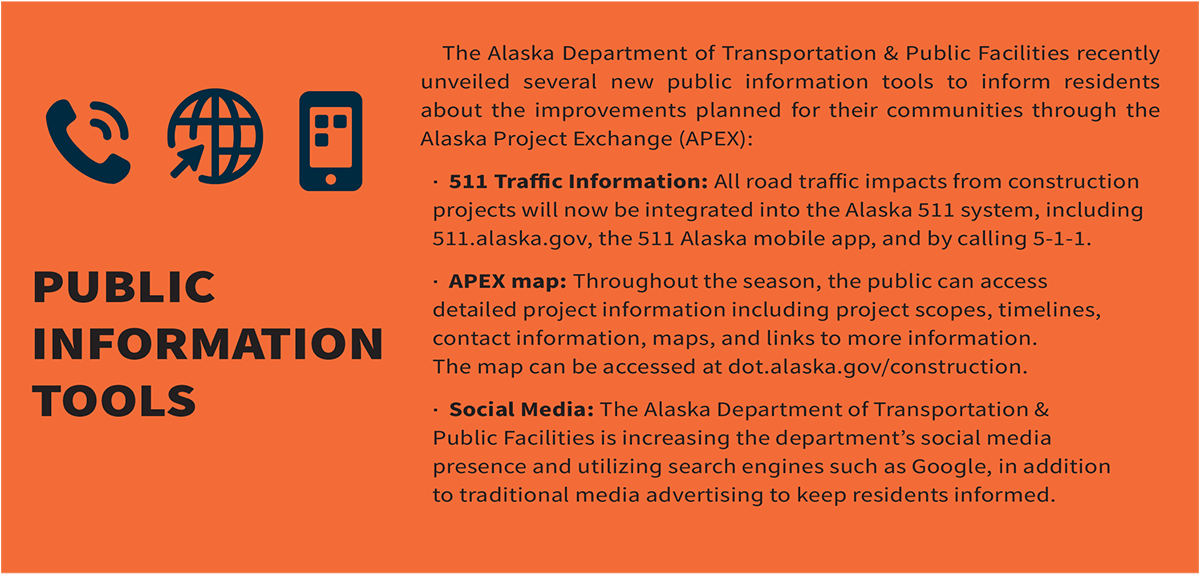ccording to the Alaska Department of Transportation & Public Facilities, the 2023 construction season promises to be robust. More than 140 transportation improvement projects are scheduled for this construction season in Alaska, including airport upgrades, bike lanes, docks, roads and highways, and sidewalks in sixty-four communities. While construction zones are necessary, they often pose hazards to workers and drivers alike. Effective traffic control, signage, and other markings can be the difference between a job safely done and someone getting hurt.
Addressing mobility and safety issues surrounding work zones begins with the project development process and continues until the project is finalized. Developing a communications plan for local businesses, residents, motorists, and the general public remains key to keeping workers and drivers safe. Road closure details, expected work zone impacts, and changing conditions during the construction project are examples of the information that needs to be communicated throughout the duration of the project.
Transportation management plans take several things into consideration, such as anticipated construction conditions, access requirements, and existing road users.
Fortunately, Alaska has several companies that are extremely capable of meeting the planning and communication needs of road work projects.
Jolt Construction does everything for road construction projects except building the road. As Cole explains, “We do flagging in work zones, striping the roads, hydroseeding, mulching, landscaping, cleaning culverts, and adding markers as needed on the side of the roads.”
Keeping the safety of the workers and drivers as the top priority, Jolt Construction begins every job with a solid plan.

Stacey Coy has been one of the flaggers that drivers might see in the middle of nowhere or the middle of the night. She started in 1995, a few years after the launch of Northern Dame, a subcontractor that provides traffic maintenance and control plans, message boards, and flagger training. Coy became company president in 2017 after her mother-in-law, Doris Coy, retired.
Among its services, Northern Dame maintains and rents barricades, traffic cones, and other traffic control equipment. The company also appoints supervisors to set up, take down, and maintain all traffic control equipment and to oversee any flaggers to ensure safe, smooth traffic flow.
President
Jolt Construction & Traffic Maintenance
When training flaggers, Coy looks for key personality components. “Being an effective flagger requires confidence. This is not a job for a timid person because you are commanding the respect of traffic. In our classes we tell our students not to be shy; this is not a job for a timid person,” she says.
Flaggers manage most traffic control in construction zones, but when a diversion is longer than normal the transportation management plan may call for pilot cars. With a goal of getting vehicles through work zones simply and safely and keeping workers free from harm, pilot cars lead vehicles through lengthy work zones while keeping an eye on potential adverse situations.
In urban areas where traffic congestion and high speeds present more potential danger to road construction workers, law enforcement sometimes plays a role. That might be during traffic control setup or removal, night work operations, or brief stoppage of all traffic in one or both directions.
Project managers also need to coordinate with emergency services to ensure they can respond throughout the construction. This may require wider lanes than necessary for normal vehicles, turnarounds, or alternate routes.
New challenges arise for projects in remote areas, so Jolt Construction uses creative transport methods to get supplies to the job sites. “Sometimes we fly supplies into the villages, and other times we use the marine highway system, sending supplies on a barge up the Yukon River on a cruise from village to village,” says Cole. “Variety does keep things interesting. With a continuously changing infrastructure, you must stay alert. And when you can meet the needs in remote areas, it’s rewarding. We also find that the folks in the villages are eager to see the projects completed and are willing to help, so we utilize a lot of the local people whenever possible.”
Safety challenges vary depending on the location of road work projects and the volume of traffic. In urban settings, the likelihood of distracted drivers is more pronounced, and cellphones are often the culprit. “We constantly must watch for distracted drivers in urban areas. But when you get into more rural areas, people seem to pay more attention and are not as distracted,” Cole says.
Coy also sees cellphone usage as one of the biggest challenges when it comes to traffic safety. “We’re always on the lookout for drivers not focused on driving. When drivers focus on their cellphones instead of the traffic surrounding them, it’s not uncommon to have accidents that can sometimes cause chain reactions,” says Coy.
Overall, watching out for fellow Alaskans is key to minimizing safety concerns. “If I could offer any advice to motorists, it would be to please slow down when you see those road construction signs,” says Coy. “You just never know who the flagger on the side of the road is, and it could be a friend or family member. We need to take care of each other.”